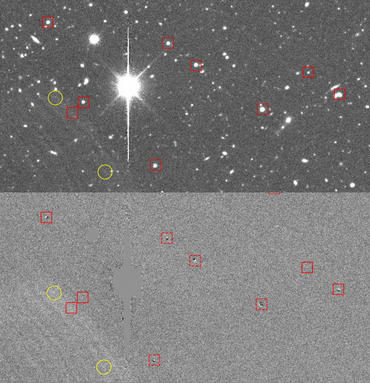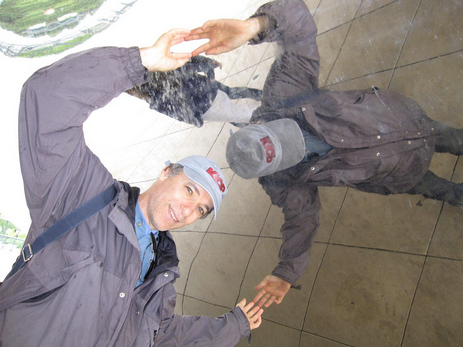There are lights flickering on and off across the universe. Cepheid Variable stars, gamma ray bursts and exploding stars are some examples of “transients,” objects whose brightness varies over time. The Dark Energy Survey is seeking out thousands of thermonuclear exploding stars, also called Supernovae, in order to measure the properties of dark energy. To do this, DES takes a picture of a patch of sky on one night, and then makes sure to return and take another picture of the same patch within a few days: visiting the same patch periodically allows us to see if any objects have become brighter over the course of days or weeks.
In this paper, we describe a complex software package that rapidly analyzes the terabytes of images from the Dark Energy Survey (DES) in order to discover new supernovae. Our transient-detection software has ~70,000 lines of code, not including numerous pre-existing packages of code. One of the main functions of the code is to create a “difference image”. First, a “reference” image (the before picture) of the sky is taken. Then, within a few days or a week, a “search” image (the after picture) is taken of the same patch of sky. We expect that new or moving objects will appear in the search image, but not in the reference image: the difference image is the result of subtracting these two images, which reveals the new or moving objects.
We must test and monitor the code to ensure its success. We inject fake SNe near galaxies onto each image, and then check how many were found by the software. We quantify our results by measuring the fake “efficiency” of detection for supernovae near and far. The efficiency is the fraction of injected fakes that are detected. If the efficiency equals one, that means that all fakes are detected; while an efficiency of zero means that none are detected.
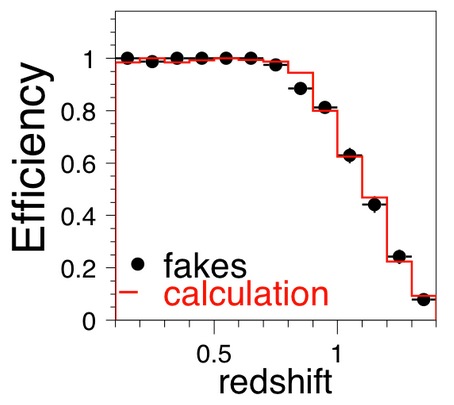
Detection efficiency as a function of distance away from Earth. The black points are measured detection efficiency from injecting fake supernovae. The red line is a calculation.The red curve in the figure shows a prediction for ideal efficiency. The prediction is based solely on calculations: no images or fakes were used to make this prediction. The good agreement between the ideal and measured efficiency shows that our transient-detection software is working very well.
While the software works well for our main science goal of finding bright supernovae , we found problems measuring the brightness of very faint transients (that are not Type Ia supernovae) in very bright galaxies.
This figure shows the measured fake efficiency at several distances (also called redshifts) in solid black points. At smaller distances (i.e., smaller redshift), detections are a bit easier, so the efficiency is very high — one, as expected. However, at farther distances, like more than 8 billion light-years (redshift is approximately 1), supernovae are harder to detect. At this distance the efficiency of our detections has fallen to 50%: we can only detect the brighter half of the SNe Ia at such a large distance. Nevertheless, our detection efficiency is better than
in any previous wide-area survey, thanks to the quality of the sensors in of the DES camera.
About the Paper Author
Rick Kessler is a Senior Research Associate at the University of Chicago’s Kavli Institute for Cosmological Physics.
About The DArchive Authors & Editors
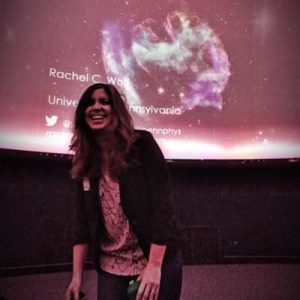
Rachel C. Wolf is an astrophysics PhD candidate at the University of Pennsylvania. She is primarily interested in how to best use Type Ia supernovae to understand more about the evolution of our universe. Most of her work has focused on studying correlations between supernova brightness and host-galaxy properties and on creating new statistical techniques to compare observational data to cosmology theory. Rachel is also very passionate about science education and public outreach. She is involved in many projects in the Philadelphia community and serves as one of the co-coordinators of Education & Public Outreach for DES.
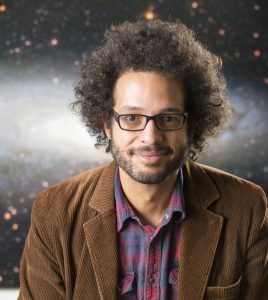
Brian Nord is a post-doc at Fermi Accelerator National Laboratory. He did his graduate work on galaxy clusters and simulations of large-scale structure at the University of Michigan. He has been working with the DES strong lensing group for the past 3 years. Nord is also one of the co-coordinators of Education & Public Outreach for DES. Nord also does time lapse photography and has an encyclopedic memory of movies and television from the 1980’s.
